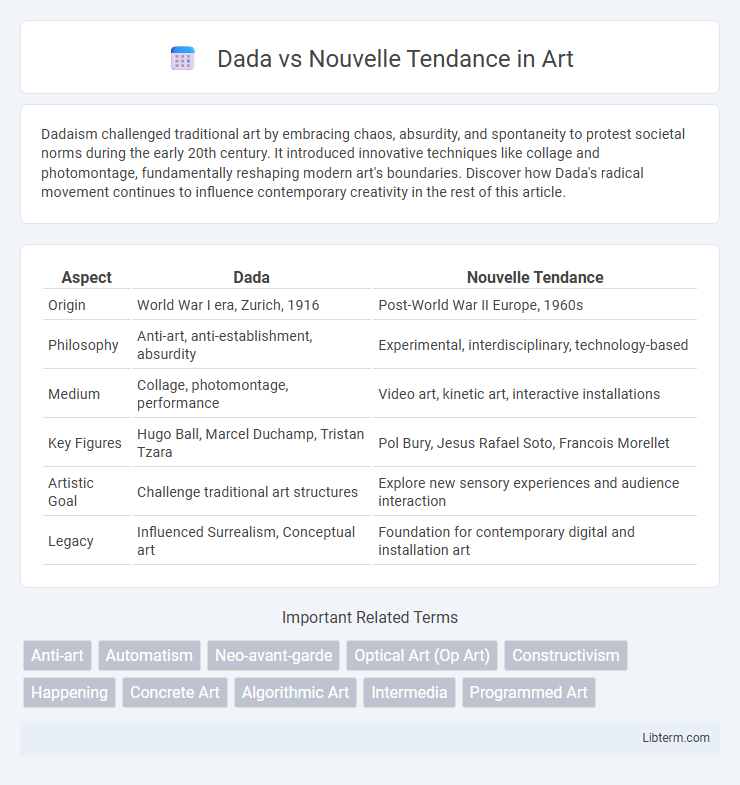Dadaism challenged traditional art by embracing chaos, absurdity, and spontaneity to protest societal norms during the early 20th century. It introduced innovative techniques like collage and photomontage, fundamentally reshaping modern art's boundaries. Discover how Dada's radical movement continues to influence contemporary creativity in the rest of this article.
Table of Comparison
| Aspect | Dada | Nouvelle Tendance |
|---|---|---|
| Origin | World War I era, Zurich, 1916 | Post-World War II Europe, 1960s |
| Philosophy | Anti-art, anti-establishment, absurdity | Experimental, interdisciplinary, technology-based |
| Medium | Collage, photomontage, performance | Video art, kinetic art, interactive installations |
| Key Figures | Hugo Ball, Marcel Duchamp, Tristan Tzara | Pol Bury, Jesus Rafael Soto, Francois Morellet |
| Artistic Goal | Challenge traditional art structures | Explore new sensory experiences and audience interaction |
| Legacy | Influenced Surrealism, Conceptual art | Foundation for contemporary digital and installation art |
Introduction to Dada and Nouvelle Tendance
Dada emerged during World War I as an avant-garde movement characterized by its embrace of absurdity, anti-art, and a rejection of traditional aesthetics, aiming to challenge societal norms through satire and irrationality. Nouvelle Tendance appeared in the 1960s as a European art movement focused on kinetic and op art, emphasizing systematic structure, optical illusions, and viewer interaction to explore perception and movement. Both movements contributed significantly to the evolution of modern art by questioning conventional forms and encouraging experimental approaches.
Historical Origins and Cultural Context
Dada emerged during World War I as an anti-war, anti-establishment movement centered in Zurich, emphasizing absurdity and the rejection of traditional artistic values, while Nouvelle Tendance arose in the 1960s in Europe, especially in Yugoslavia, as a reaction against abstract art, promoting new media and kinetic art. Dada's historical origins are deeply tied to the chaos and disillusionment of wartime, rejecting logic and embracing chaos to critique bourgeois culture. Nouvelle Tendance's cultural context reflects post-war technological optimism and the desire to explore perception and interactivity in art through scientific approaches.
Key Philosophies: Dada vs Nouvelle Tendance
Dada emphasized anti-art, absurdity, and the rejection of traditional aesthetics as a protest against the horrors of World War I, promoting spontaneity and irrationality. Nouvelle Tendance focused on kinetic and optical art, exploring viewer interaction, perception, and scientific principles to create dynamic, often geometric works. The key philosophical divide lies in Dada's anarchic negation of meaning versus Nouvelle Tendance's structured investigation of movement and visual experience.
Major Artists and Influencers
Dada's major artists included Hugo Ball, Tristan Tzara, and Marcel Duchamp, who challenged traditional art norms with absurdity and anti-art principles during World War I. Nouvelle Tendance, emerging in the 1960s, featured artists like Enrico Castellani and Francois Morellet, emphasizing kinetic and optical art with systematic structures and geometric forms. Both movements significantly influenced avant-garde art, but Dada prioritized chaos and anti-establishment ideals, while Nouvelle Tendance focused on order and perceptual exploration.
Artistic Techniques and Mediums
Dada artists employed unconventional techniques such as collage, photomontage, and assemblage, using found objects and everyday materials to challenge traditional aesthetics. Nouvelle Tendance focused on kinetic art, op art, and light art, utilizing technology, geometric patterns, and optical illusions to engage viewers in an interactive visual experience. Both movements emphasized breaking boundaries, but Dada leaned toward anti-art practices while Nouvelle Tendance explored systematic and scientific approaches to perception.
Impact on Contemporary Art Movements
Dada's radical anti-art ideology and embrace of absurdity profoundly influenced contemporary art movements by challenging traditional aesthetics and promoting experimental practices. Nouvelle Tendance, emerging in the 1960s, expanded on Dada's conceptual groundwork by integrating technology, kinetic art, and viewer interaction, directly impacting kinetic art, op art, and conceptual art. Both movements collectively paved the way for postmodernism by questioning artistic authorship and emphasizing process over product.
Aesthetic Differences and Visual Styles
Dada embraced chaotic, anti-art aesthetics characterized by collage, photomontage, and absurd imagery challenging traditional art norms. Nouvelle Tendance favored systematic, geometric abstraction with repetitive patterns, optical illusions, and kinetic elements emphasizing controlled visual experimentation. Dada's visual style was rooted in irrationality and spontaneity, while Nouvelle Tendance prioritized rationality and structured visual perception.
Reception and Critique in Art Circles
Dada faced harsh criticism from traditional art circles for its radical rejection of conventional aesthetics, being dismissed initially as anarchic and nonsensical. Nouvelle Tendance was received more positively, recognized for its innovative exploration of kinetic and op art that aligned with emerging scientific and technological interests. Both movements significantly influenced contemporary visual arts, provoking ongoing debates about the role and definition of art in modern society.
Lasting Legacy and Influence
Dada's lasting legacy lies in its radical challenge to traditional art and culture, paving the way for conceptual and absurdist movements by embracing chaos and anti-establishment ideals. Nouvelle Tendance reinforced this foundation by emphasizing kinetic art and viewer participation, influencing later interactive and multimedia art forms. Together, these movements shaped contemporary art's evolution, promoting experimental approaches and questioning conventional aesthetics.
Conclusion: Comparing Artistic Significance
Dada challenged conventional art by embracing irrationality, spontaneity, and anti-establishment themes, profoundly influencing modern art's evolution. Nouvelle Tendance emphasized interactivity, optical effects, and viewer participation, pushing the boundaries of perception and technology in art. Both movements redefined artistic significance by rejecting traditional aesthetics, yet Dada's historical impact remains foundational, while Nouvelle Tendance expanded the experiential dimensions of contemporary art.
Dada Infographic

 libterm.com
libterm.com